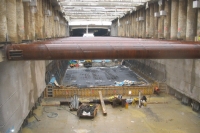Koralm, Graz - Klagenfurt Railway Line,
Feldkirchen - Wettmannstätten section
Client: Austrian Railways Infrastructure Construction AG
Development Period: since 1996
With the Koralm Railway Line, the cities Graz and Klagenfurt are to be connected by a new, 124 km long, high-performance railway track.
Along this 24 km long section, numerous bridges, a subsurface route (total length 5.2 km) and a lengthy underpass below the A9 Pyhrn Motorway (built with open cut method) are planned. Furthermore, the Hengsberg Tunnel with a total length of 1.7 km is situated along this project. 1.0 km of the tunnel is being built using the mining technique. For the remaining section cut-and-cover methods are used. On the one hand, a bottom-up method with bored pile walls as side support, and on the other hand a top-down method (also between protecting bored piles) have been implemented.
BGG Consult has been attending to this project section in the field of geotechnics, hydrogeology and geology since the feasibility evaluation phase. Initially, expert's reports have been compiled in the route selection process. For the environmental impact assessment, the fundamental facts were integrated in the expert's report on ground water / mountain water (including geology). Subsequently, the application documents for the construction permission and the expert's reports for the tenders were prepared. All conclusions have been based on the results of extended subsoil explorations.
During construction, geotechnical and hydrogeological consulting is provided by BGG Consult. This includes the optimisation of foundations, building pits and dewatering concepts as well as the supervision and monitoring of the extensive earth works.
Cut-and-Cover Hengsberg South:
At the southern side of the Hengsberg Tunnel, cover layer material and highly weathered "Miocene" respectively exist across the tunnel section over a length of 600 m. In addition to that, slope deformations have been detected above the tunnel alignment. Due to this adverse subsoil situation and in order to avoid extended temporary cuts, a cut-and-cover tunnel between two bored pile walls has been selected - in coordination with the tunnel designer - as the appropriate construction method, already in the early stages of the project. Over a length of 400 m, an arch section (see picture) is being carried out. In the remaining 200 m of the open cut, a rectangular section with excavation under the tunnel roof has been designed. The ground water exchange is accomplished by filter layers placed below the structure.
The example of this project illustrates that it is possible to handle also difficult subsoil conditions without cost increase and time delay, if the subsoil situation is assessed - based on an accurate exploration - adequately and early enough.
June 2009
